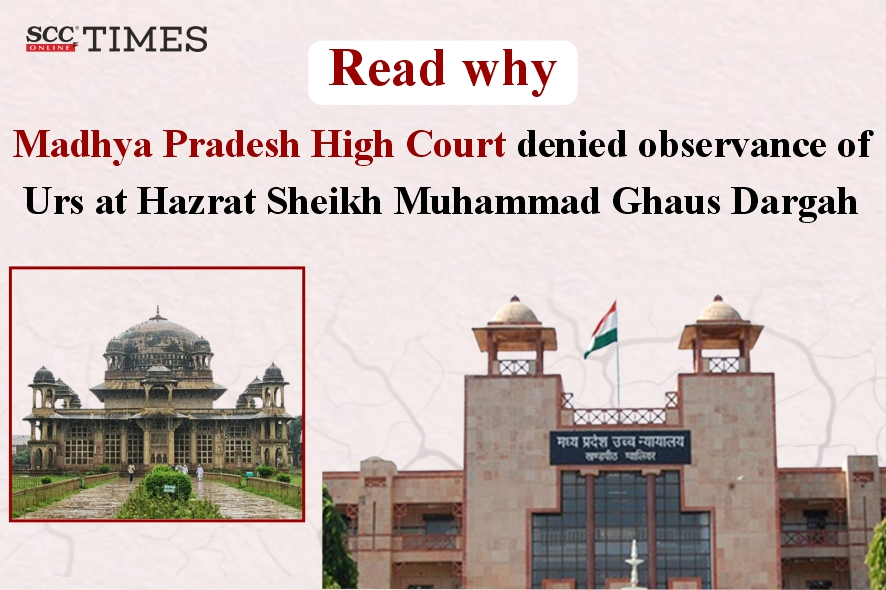Madhya Pradesh High Court: In an appeal filed contesting the rejection of his writ petition against the Archaeological Survey of India’s (‘ASI’) refusal to grant the petitioner permission to observe Urs at the Dargah of Hazrat Sheikh Muhammad Ghaus (‘the Dargah’), the Division Bench of Anand Pathak* and Hirdesh, JJ., rejected the appeal, holding that the monument was a centrally protected monument of national importance, no such permission for use could be granted to the petitioner. The Court also concurred that the petitioner did not come to the Court with clean hands.
Background
The petitioner was the Sajjada Nashin of the Dargah and allegedly the legal heir of Hazrat Sheikh Muhammad Ghaus as well. According to the petitioner, various religious and cultural activities have been performed in the Dargah for the last 400 years. However, after the ASI declared the Dargah as a protected monument, such activities were prohibited or curtailed, including Urs (Jalsa) and Namaz.
In 2024, the petitioner submitted an application to the ASI requesting permission to observe Urs at the Dargah, but the said permission was denied, stating that said monument was a protected monument under the Ancient Monuments and Archaeological Sites and Remains Act, 1958 (“the 1958 Act”) and it could only be opened from sunrise to sunset. As per Ancient Monuments and Archaeological Sites and Remains Rules, 1959 (“the 1959 Rules”), no such permission could be granted. Furthermore, as per Section 30 of the 1958 Act and Rule 8 of the 1959 Rules, any such act would be punishable with imprisonment for two years with a fine of Rs. 1 Lakh. Aggrieved, the petitioner filed a writ petition, but it was rejected vide the impugned order.
Hence, he filed the present appeal.
Analysis
At the outset, the Court noted that the Tomb of Muhammad Ghaus, Gwalior (‘the monument’), was a Centrally Protected Monument and declared as a National Monument in 1962. Since then, it had been maintained by the Central Government/ASI.
Upon perusal of the aim and object of the 1958 Act, the Court stated that the very spirit of the said Act was to preserve history, culture, and civilization for posterity and guidance of future generations. Therefore, the intent was to preserve such monuments and regulate them for visitors to gain knowledge about our past and undertake research for the future.
Furthermore, the Court remarked that the Constitution makers were also cognizant of the importance of preserving monuments, reflected in Articles 49 and 51A(f) of the Constitution, which places obligations on the State and citizens to protect and preserve monuments.
Noting the aforesaid, the Court stated that if the petitioner was permitted to conduct Urs and Namaz, the monument would suffer damage as tents would be installed, nails would be inserted, and lights would be fixed. Additionally, since the monument was not declared an archaeological monument of national importance under Section 5 or 13 but under Section 4 of the 1958 Act, no such permission for use could be granted. The Court stated that the monument did not fall under the place of worship and shrine. Therefore, it could not be used.
The Court also noted that Section 18 of the 1958 Act gives the public the right of access to any protected monument, and if the prayer put forth by the petitioner was accepted, then it would certainly hinder the right of access given to the public. Thus, the right of access to the public as visitors deserved protection. The Court remarked that this right was an important statutory right and deserved protection.
Further, upon perusal of Section 19 of the 1958 Act, the Court noted that no person, including the owner or occupier of a protected area, shall construct any building/or make operation within the protected area or carry on any mining, quarrying, excavating, blasting or any operation of a like nature in such area, or utilise such area or any part thereof. In this regard, the Court noted that the civil suits for ownership of the monument herein were dismissed long back. Therefore, on this count as well, the petitioner had no case on merits.
The Court stated that it was the duty of the ASI and the District Administration to protect the monument, which was of national importance, with utmost care and strictness. The constitutional vision and morality ought to prevail over personal and vested interests. The Court added that the monument deserved to be protected with utmost care and caution, and no activity as sought by the petitioner could be permitted lest the monument lose its originality, sanctity, and vitality.
As to the facts, the Court pointed out that the petitioner did not challenge the rejection of his request to perform Urs at the Dargah. Thus, in the absence of any such challenge, the Court stated that no relief could be granted to the petitioner.
Accordingly, the Court affirmed the impugned order. The Court agreed with the Writ Court’s findings, which concluded that the petitioner did not approach the Court with clean hands as he concealed facts and had other motives.
Thus, the appeal was rejected.
[Sabla Hasan v. Union of India, 2025 SCC OnLine MP 4721, decided on 16-06-2025]
*Judgment authored by: Justice Anand Pathak
Advocates who appeared in this case:
For the appellant: Ashish Srivastava
For the respondent: Dy. Solicitor General Praveen Kumar Newaskar and Additional Advocate General Vivek Khedkar




